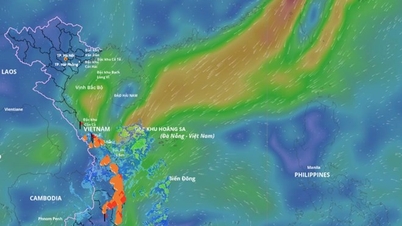Our planet has only one moon. This natural satellite is even named the Moon.
In the early days when humans began to explore the stars, we only knew the Moon as a single natural satellite. But with the development of science , we gradually discovered many more natural satellites in the Solar System that are similar or many times larger than the Earth's Moon.
According to Live Science , based on the definition of a natural satellite, Earth in the past and present may have had more than one moon.

The Earth has more "moons" than we thought. (Photo: HowStuffWorks)
According to astronomer Gábor Horváth of Eötvös Loránd University (Hungary), the Moon is still the only artificial satellite that holds the title of Earth's only solid moon. However, the Moon is not the only object that is pulled into Earth's orbit because there are also dust clouds orbiting our planet. By definition, these dust clouds are considered small moons, quasi-artificial satellites or "ghost moons".
So the question of how many moons Earth has is more complicated than we think. The number has changed over time – from zero, to one, to sometimes many moons.
Back in the early days of Earth, about 4.5 billion years ago, our planet had no moons. Then, about 4.4 billion years ago, a protoplanet roughly the size of Mars called Theia collided with Earth. Huge chunks of our planet were ejected into space, becoming the “foundation” for our natural satellites.
These pieces of rock and soil then came together in just a few hours or so and gradually formed the Moon we know today.
Currently, in addition to the Moon, the Earth also has "mini-moons" with diameters of only a few centimeters or up to several meters that are pulled into the planet's orbit by gravity but only for a short time.
A typical example is in 2006, the 6-meter-long asteroid named 2006 RH120 orbited the Earth for a record time of up to 18 months before continuing to drift in space. Or most recently, the case of the 3.5-meter-long asteroid 2020 CD3, which orbited the Earth for up to 3 years – it is no different from the planet's second moon.
In addition to natural satellites that come and go from Earth's orbit, there are also space objects that NASA calls quasi-satellites, such as asteroid 3753 Cruithne. These space rocks orbit the Sun so closely like Earth that they stick with our planet throughout its 365-day orbit.

The Earth has many natural satellites that come and go in orbit and they revolve around our planet much like the Moon.
Some space objects, such as asteroid 2010 TK7, are also called "moons" because they are pulled into orbit by the gravitational pull of the Sun–Earth or Earth–Moon.
According to Horváth, parallel to the formation of the solid moon and the stabilization of its orbit around Earth, there also appeared Lagrangian points, gravitational positions that held interplanetary dust particles for billions of years around our planet. (Lagrangian is the gravitational attraction of two larger objects that creates regions of centripetal force.)
Some astronomers call these cloud particles "ghost moons" or Kordylewski clouds, after the Polish astronomer who discovered them in the 1960s.
These “ghost moons,” however, will never form a solid moon because the dust cannot coalesce, coalesce, or stick together, Horváth said. While the Lagrange points remain constant, the material in them is constantly moving in and out of the dust cloud.
Tra Khanh (Source: Live Science)
Useful
Emotion
Creative
Unique
Wrath
Source



![[Photo] Prime Minister Pham Minh Chinh and United Nations Secretary-General Antonio Guterres attend the Press Conference of the Hanoi Convention Signing Ceremony](https://vphoto.vietnam.vn/thumb/1200x675/vietnam/resource/IMAGE/2025/10/25/1761391413866_conguoctt-jpg.webp)
![[Photo] National Assembly Chairman Tran Thanh Man receives United Nations Secretary-General Antonio Guterres](https://vphoto.vietnam.vn/thumb/1200x675/vietnam/resource/IMAGE/2025/10/25/1761390815792_ctqh-jpg.webp)


![[Photo] Prime Minister Pham Minh Chinh receives United Nations Secretary-General Antonio Guterres](https://vphoto.vietnam.vn/thumb/1200x675/vietnam/resource/IMAGE/2025/10/25/1761390212729_dsc-1484-jpg.webp)


















![[Photo] General Secretary To Lam meets with General Secretary and President of Laos Thongloun Sisoulith](https://vphoto.vietnam.vn/thumb/1200x675/vietnam/resource/IMAGE/2025/10/25/1761380913135_a1-bnd-4751-1374-7632-jpg.webp)













































































Comment (0)